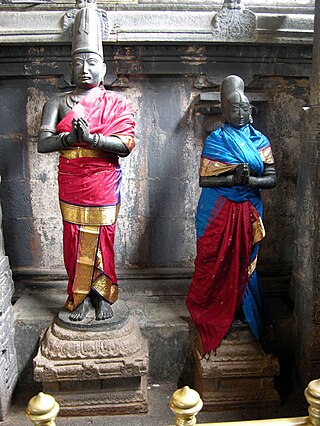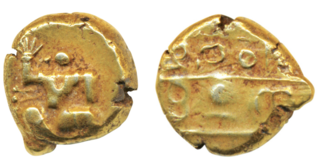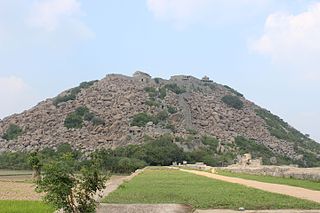
Krishnadevaraya was an emperor of the Vijayanagara Empire reigning from 1509 to 1529. He was the third monarch of the Tuluva dynasty, and is considered to be one of the greatest rulers in Indian history. He ruled the largest empire in India after the fall of the Islamic Delhi Sultanate. Presiding over the empire at its zenith, he is regarded as an icon by many Indians. Krishnadevaraya earned the titles Andhra Bhoja, Karnatakaratna Simhasanadeeshwara, Yavana Rajya Pratistapanacharya, Kannada Rajya Rama Ramana, Gaubrahmana Pratipalaka and Mooru Rayara Ganda. He became the dominant ruler of the peninsula by defeating the sultans of Bijapur, Golconda, the Bahmani Sultanate and the Gajapatis of Odisha, and was one of the most powerful Hindu rulers in India.

Achyuta Deva Raya was an emperor of Vijayanagara who succeeded his older brother, Krishnadevaraya, after the latter's death in 1529 CE.

BukkaRaya I was an emperor of the Vijayanagara Empire from the Sangama Dynasty. He was a son of Bhavana Sangama, claimed by Harihara II to be of Yadava lineage. The first Bahmani-Vijayanagar War occurred during the reign of Bukka Raya I, in which he was besieged, and sued for peace.

Gingee, also known as Senji or Jinji and originally called Singapuri, is a panchayat town in Viluppuram district in the Indian state of Tamil Nadu. Gingee is located between three hills covering a perimeter of 3 km, and lies west of the Sankaraparani River.
Mallikarjuna Raya was an Emperor of Vijayanagara from the Sangama Dynasty.

The Thanjavur Nayakdynasty were the rulers of Thanjavur in the 15th and 17th centuries. The Nayaks, who belonged to the Telugu-speaking Balija social group were originally appointed as provincial governors by the Vijayanagara Emperor in the 15th century, who divided the territory into Nayak kingdoms which were Madurai, Tanjore, Gingee and Kalahasthi. In the mid-15th century they became an independent kingdom, although they continued their alliance with the Vijayanagara Empire. The Thanjavur Nayaks were notable for their patronage of literature and the arts.
Tuluva Narasa Nayaka was an Indian general, Bunt chieftain and later an imperial regent who founded the Tuluva dynasty of the Vijayanagara Empire. He was the father of the emperors Viranarasimha Raya, Krishnadevaraya and Achyuta Deva Raya.
Vira Narasimha Raya became the Emperor of Vijayanagara after the death of his predecessor Narasimha Raya II. He was the older half-brother of Krishnadevaraya.

Vellore Fort is a large 16th-century fort situated in heart of the Vellore city, in the state of Tamil Nadu, India built by the Emperors of Vijayanagara. The fort was at one time the imperial capital of the Aravidu Dynasty of the Vijayanagara Empire. The fort is known for its grand ramparts, wide moat and robust masonry.
Sadasiva Raya was an Emperor of Vijayanagara who reigned from 1542 to 1570 CE. When the Vijayanagara Emperor Achyuta Raya died in 1542 CE, his son, Venkata I, succeeded him. However, Venkata I was assassinated six months later. Sadasiva Raya, who was the nephew of Achyuta Raya, became the new Emperor in accordance with the Aliya succession laws prevalent among the Tuluvas. Sadasiva Raya, along with his Prime Minister Rama Raya, restored the Vijayanagara empire's power, which had diminished after the reign of Krishna Deva Raya. The strategy was to play the Turko-Persian Sultanates in the Deccan against each other by first allying with one and then the other.
Tirumala Deva Raya was the first crowned Emperor of Vijayanagara from the Aravidu Dynasty. He was the younger brother of Rama Raya and the husband of princess Vengalamba, making him the son-in-law of Emperor Krishna Deva Raya. Following the Battle of Talikota, he rescued the last Tuluva Emperor, Sadasiva Raya, and relocated the imperial capital to Penukonda. After Sadasiva's death in 1570 CE, he ascended as the Emperor of Vijayanagara. He was succeeded by his son, Sriranga I in 1572.
Sriranga II was nominated in 1614 by Emperor Venkata II to succeed him as the Emperor of Vijayanagara. Sriranga was supported by a faction headed by Yachama Nayaka of Recherla Velama dynasty, one of the Venkata II's loyal viceroys and commanders and Nayak of Venkatagiri, but was not favored by a set of nobles headed by Gobburi Jagga Raya, brother of Venkata II's favourite consort, Empress Bayamma.
Rama Deva Raya ascended the throne after a gruesome war in 1617 as the Emperor of Vijaynagara. In 1614 his father, Sriranga II the preceding emperor and his family were murdered by rival factions headed by Jagga Raya, who was one of their kins. Rama Deva himself was smuggled out of the prison by Yachama Naidu, a faithful commander and the viceroy of earlier emperor Venkata II.
Sriranga III was the last ruler of the Vijayanagara Empire, who came to power in 1642 following the death of his uncle Venkata III. He was also a great grandson of Aliya Rama Raya.

Venkatapati Raya was the third Emperor of Vijayanagara from the Aravidu Dynasty. He succeeded his older brother, the Emperor Sriranga Deva Raya as the ruler of Vijayanagara Empire with bases in Penukonda, Chandragiri and Vellore. His reign of nearly three decades saw a revival in the strength and prosperity of the empire. He successfully dealt with the Turko-Persian Deccan sultans of Bijapur and Golkonda, the internal disorders, promoting economic revival in the realm. He subdued the rebelling Nayakas of Tamil Nadu and parts of present-day Andhra Pradesh.

Venkata III was the grandson of Aliya Rama Raya. Venkata III belonged to a Telugu family. and became the King of the Vijayanagara Empire from 1632 to 1642. His son-in-law Pedda Koneti Nayak was ruler of Penukonda. His brothers-in-law were Damarla Venkatappa Nayaka and Damarla Ayyappa Nayaka, both sons of Damarla Chennapa Nayakadu.
Venkata I was an Emperor of Vijayanagara from the Tuluva Dynasty. He was the son of Emperor Achyuta Deva Raya, whom he succeeded in 1542 CE.
Gobburi Jagga Raya was a de facto King of Vijayanagara Empire on behalf adopted nephew named Chenga Raya, a rival claimant to the Vijaynagara thorne. He was the brother of Venkata II's favourite Queen Obayamma who was bequeathed the Pulicat region and belonged to the Gobburi family of Nayaks under the Vijayanagar Empire.
Damarla Chennapa Nayaka was a Nayaka ruler of Kalahasti and Vandavasi under the suzerainty of Vijayanagar emperor Venkatapati Raya. He was also the Dalavoy or the Commander-in-Chief of the emperor.
This battle caused complete destruction of the already declining Vijayanagara Empire. It was a civil war fought by the claimants for the throne of the Vijayanagara Empire. Jagga Raya challenged the Sriranga Authority on behalf of his nephew.







